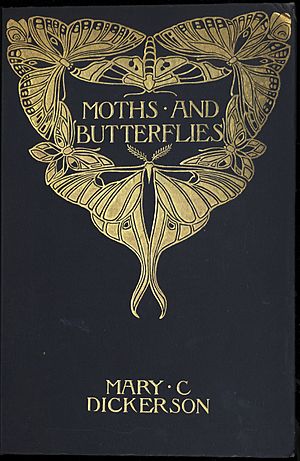Mary Cynthia Dickerson facts for kids
Quick facts for kids
Mary Cynthia Dickerson
|
|
|---|---|

Dickerson circa 1912
|
|
| Born | March 7, 1866 |
| Died | April 23, 1923 (aged 57) |
| Nationality | American |
| Education | |
| Scientific career | |
| Fields | Herpetology |
| Institutions | American Museum of Natural History |
| Signature | |
Mary Cynthia Dickerson (1866–1923) was an American scientist who studied herpetology. This means she studied reptiles and amphibians. She was the very first curator of herpetology at the American Museum of Natural History. She also edited The American Museum Journal for ten years. This magazine was later renamed Natural History.
Mary Dickerson wrote two important books. These were Moths and Butterflies (1901) and The Frog Book (1906). She also wrote many articles for both scientists and the public. She discovered and described over 20 new species of reptiles. Four different types of lizards are named after her to honor her work.
Contents
Early Life and Education
Mary Cynthia Dickerson was born in Hastings, Michigan. Her birthday was March 7, 1866. She had three younger brothers whom she helped care for.
It was not easy for girls to go to college back then. But Mary worked hard to pay for her own education. She studied at the University of Michigan from 1886 to 1891. After that, she taught high school biology for four years. She then went to the University of Chicago. She earned her Bachelor of Science degree there in 1897.
Teaching and Early Books
From 1897 to 1905, Mary Dickerson led the zoology and botany departments. This was at the Rhode Island Normal School. She often took her students on nature walks. They explored the outdoors in Providence. She used her observations from these walks to write her books.
Her first book, Moths and Butterflies, came out in 1901. It included her own photographs. People liked the book a lot. One reviewer said it was "an excellent book." Another called it "free from everything like pedantry." This meant it was easy to understand.
Her second book, The Frog Book, was published in 1906. It focused on the frogs and toads of North America. Many people wanted a book like this. A reviewer for Science said it showed the habits of common frogs well. It also showed their eggs and tadpoles, which was new.
From 1907 to 1908, she taught at Stanford University. She worked with another scientist, David Starr Jordan. Together, they described a new species of fish. In November 1908, she started working at the American Museum of Natural History. She stayed there for the rest of her career.
Work at the American Museum of Natural History
Mary Dickerson first joined the American Museum of Natural History as an assistant. She worked in the department of Woods and Forestry. She even wrote a guide for the forestry hall. In 1911, she became a curator.
In 1909, the museum created a new department. It was for Ichthyology (fish) and Herpetology (reptiles and amphibians). Mary Dickerson was the only herpetologist in this new department.
Magazine Editor
In November 1909, Mary Dickerson became an associate editor. She worked for The American Museum Journal. The next year, she became the main editor. She held this important job until 1920. During her time as editor, the magazine was renamed Natural History.
Growing the Collections
Mary Dickerson helped the museum's herpetology collections grow. She was famous for making very lifelike displays. These displays showed amphibians and reptiles in their natural homes. They were called "habitat groups." She used special techniques, like wax casting, to make them look real.
She also brought three other important herpetologists to the museum. These were Karl Patterson Schmidt, Gladwyn Kingsley Noble, and Charles Lewis Camp. Under her leadership, the museum's reptile and amphibian collection grew to almost 50,000 specimens.
In 1920, herpetology became its own separate department. Mary Dickerson was named its first curator. She believed that creating exhibits was as important as doing research.
Discoveries and Honors
Mary Dickerson described more than 20 new species of reptiles. This means she was the first to officially identify and name them. Some of these include the San Esteban chuckwalla and the Cuban sharp-nosed amphisbaena.
Four different types of lizards are named in her honor. These include Cnemaspis dickersonae and Crotaphytus dickersonae. This shows how important her work was.
By 1920, Dickerson had accomplished something remarkable. Despite other truly heavy responsibilities, she had built a functioning department from scratch, emphasizing collection growth and literature facilities in order to support the twin functions of exhibition and research in herpetology.
—Charles W. Myers, Curator Emeritus, American Museum of Natural History
Later Years
Around 1919, Mary Dickerson began to face health challenges. These challenges made it difficult for her to continue her work. She had many responsibilities as both a curator and an editor.
In November 1920, she left the museum to receive care. She passed away on April 8, 1923, at the age of 57.
See also
 In Spanish: Mary Cynthia Dickerson para niños
In Spanish: Mary Cynthia Dickerson para niños


